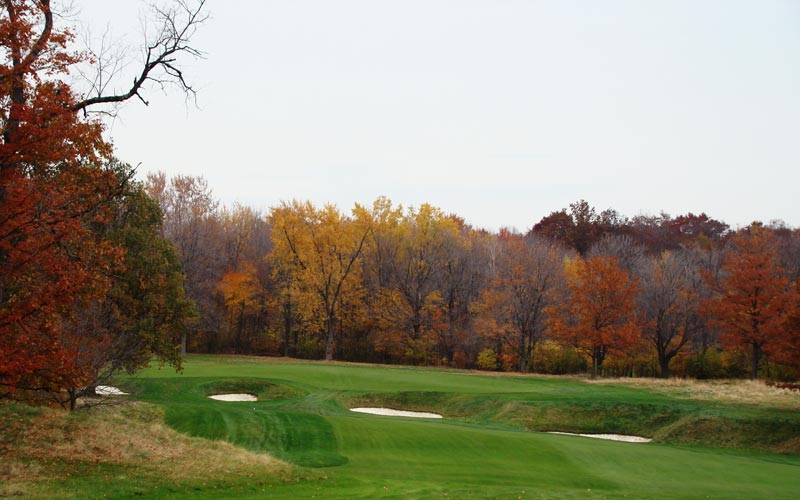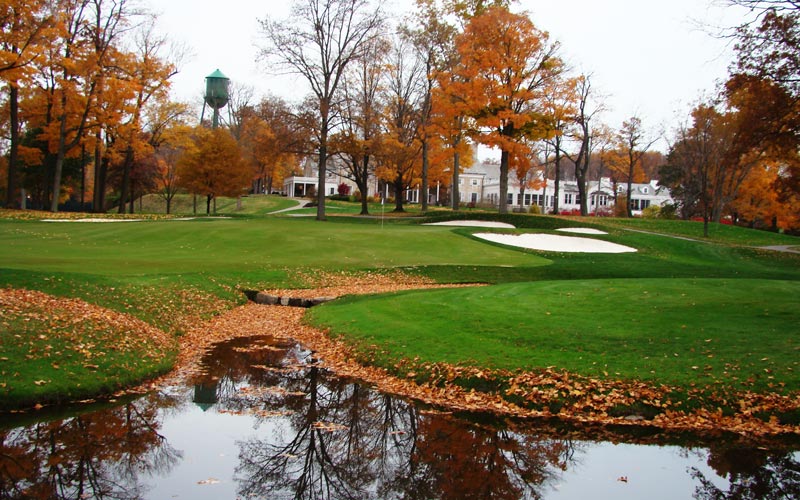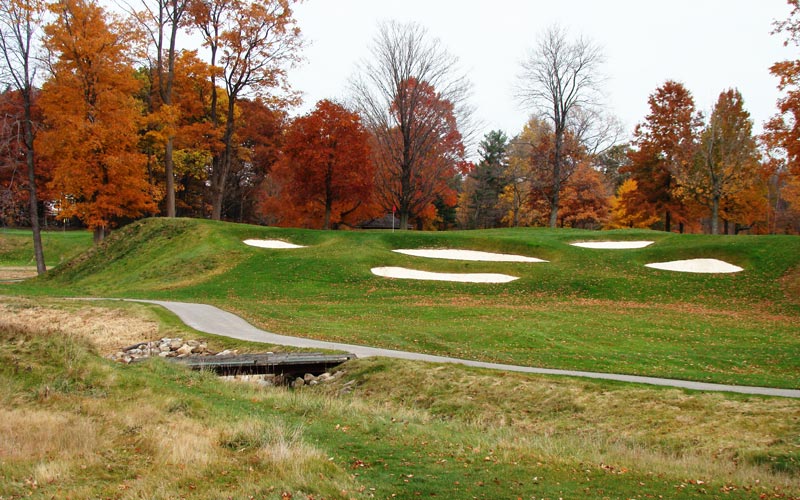Pepper Pike, OH, USA
Green Keeper: Brian Mabie

The Country Club at Pepper Pike features an old time charm that harkens back to the Golden Age of golf course architecture.
The solution to this problem came in an offer from the Van Sweringen brothers, assemblers of a railroad empire and creators of the community of Shaker Heights. In 1928, the brothers proposed that the Club relocate to their new Pepper Pike development with the promise of a large parcel of land and a loan with which to build a new clubhouse.
Being given expansive property is a great luxury for any architect. In the case of The Country Club, William Flynn took full advantage of nearly 300 acres of rolling ground in 1928 as seen in several ways. Obviously, the holes enjoy a spacious quality to them and Flynn routed the holes so that they fall over the landforms in varying ways. Flynn never got boxed in as sometimes happens to architects on tight property and as a result, there is nothing remotely approaching a weak or indifferent hole. In addition, when it came time to expand the course past the 6,800 yards that it was when Flynn left the property, there was plenty of room to do so. Finally, though eight of the holes brush along the perimeter of the property, there is gobs of room still between the playing corridors and the out of bounds. Hence, the golfer enjoys a round that is free from outside intrusions.
The highlights come when Flynn incorporates the most interesting landforms into the holes themselves. Examples include the creek at the ninth, the terraced fairway at the fifteenth and the roll-a-coaster ground movements of the seventeenth fairway. To be considered great, a course must have great holes and these are those at The Country Club.
However, it is the unrelenting strength of the supporting cast that makes The Country Club strong top to bottom. If that makes it sound like an Oak Hill or Medinah, it’s not meant to as this course features approach shots that are more varied in terms of the views that are offered of the greens. Simply put, there is no guarantee that the golfer will have a good view – or any view for that matter – of the putting surface at several holes. Sometimes, greens are perched high like at the eleventh while others are hidden behind cross-hazards like the eighth. The greens at two brutish par fours, the sixth and fifteenth, feel almost more like links holes as they are found respectively beyond the brow of a hill and a ridge. At the 585 yard twelfth, if the golfer doesn’t manage to get his first two shots within 120 yards of the green, a hillock ensures his third will be to a blind target. This true lay of the land architecture and as a result, the holes are distinctive and the course doesn’t readily remind one of any other. This is a great compliment as parkland courses can readily blur together in one’s mind. Not here though.

The game is still played by feel at The Country Club as the golfer doesn’t always enjoy a full view of its greens, including the fifteenth as seen (not seen!) from the lower portion of the fairway.

Even on the more mundane part of the property, note how the putting surface at the thirteenth is obscured from sight from the inside of the dogleg. Only by playing to the outside of the dogleg where the ground is slightly higher does the golfer gain a better view.
From the day Flynn’s course opened on August 10th, 1930, The Country Club has built a strong reputation. For instance, Lawson Little won the British and U.S. Amateurs in consecutive years, completing his ‘Little Slam’ at The Country Club in 1935. However, as has been demonstrated at a majority of Golden Age courses in the United States, time can be cruel and unnecessary changes took place to Flynn’s sterling design.
Aerials from the 1960s and forward show fairway width being compromised by tree growth and greenside bunkers being added ostensibly to ‘tighten’ the approach shot requirements. Rock outcroppings were added where the creek snakes through the ninth and tenth holes.
By the late 1990s, the balance between fun and challenge had shifted too far toward just asking the golfer to execute rifle straight shots. Flynn, who is one of the two or three all-time masters at creating interesting playing angles, would have scowled should he have stood on the first tee and looked out at what had become a scant twenty yard wide fairway. And that to a fairway with interesting undulations and movement! When conditions were fast and firm, just holding the fairway was a minor miracle, let alone trying to place it down one side or the other off the first tee. Thankfully, Flynn’s great routing was never tainted and the property with its large buffer against the outside world had not been compromised.
Realizing that something needed to be done, the club turned to Brit Stenson of IMG Design. Unlike almost all of his projects, this had two great attributes going for it from the start. First, the club possessed the full set of Flynn’s drawings for each of the eighteen holes. No guess work was required as to Flynn’s design intentions. Secondly, this project was in Stenson’s backyard and it enabled him to be there nearly every day once the work commenced with Macdonald & Sons as shapers.
Here is what multiple club champion J.T. Taylor says about the work that was carried out in 2002: ‘
While I have truly enjoyed the golf course for many years, the transformation that occurred with the renovation was nothing short of spectacular. The best changes that occurred with the renovation were (1) the return of the original fairway widths which, while making it easier to hit fairways, also forced the lazy driver of the golf ball to make up for his or her carelessness with a much tougher angle of approach into many greens, and (2) the elimination of multiple greenside bunkers (right of 4th green, left of 7th green, right of 8th green and right of 10th green) which were replaced with fairway-length grass which has made the types of recovery shots infinitely more interesting. There is nothing more enjoyable than walking to a missed approach shot next to one of these greens with a lob wedge, sand wedge, putter, three wood and eight iron and trying to “see” the proper shot to be played. This is much more interesting that stepping into a bunker with a sand wedge For me, the true test of great club in how anxious you are to get back again to play it and I can tell you that every day I look forward to returning to play it again.

There once was a bunker to the right of the tenth green but no more – the golfer must now contend with a tight lie for his recovery shot. Flynn’s front right hump makes such shots problematic.
In addition to Stenson’s work, the addition of Brian Malbie from the Firestone complex as green keeper proved a key component to restoring the course to its rightful place among the best parkland courses in the United States. Since 200X, Malbie has helped to oversee a selective tree clearing program which has opened up long vistas across the gorgeous property. In addition, he has been hydro-seeding selective areas to enhance the course’s texture. Again, the plight of too many parkland courses is that they wash out to the eye as they offer little contrast other than shades of green. Furthermore, the fast and firm conditions that Malbie promotes exacerbate the conundrum that the golfer faces at some of the tight chipping areas around the greens, as noted by Taylor above.
All told, this is a very well managed family club. Two yardages are listed below in The Holes to Note section. One is from the back tees, which stretches this Golden Age course surprisingly effortlessly to over 7,100 yards and the other is from the more reasonable 6,600 yard set. The fact that the course can play over 7,000 yards is poetic justice as Coburn Haskell, the man and name behind the Haskell ball, was famously a member here.
Holes to Note
First hole, 360/345 yards; Meandering creeks are fabulous hazards but most golf architects rarely are given the chance to work with them. By good fortune, many of the sites upon which Flynn agreed to work feature creeks (Lancaster, Huntingdon Valley, Rolling Green, Lehigh, The Cascades, etc.). Hence, it is not beginner’s luck that Flynn cleverly integrated a creek that wanders across the property into several holes. Given the changes in technology as well as its elevated tee, the first hole would be in danger of losing its playing integrity if not for the creek.

The tightly mown bank that leads up to the first green brings the creek is in play for weak approach shots and/or shots hit with too much spin.
Third hole, 340/315 yards; The club and Stenson religiously followed Flynn’s hole sketches when they embarked on this restoration project. The one exception came here at the third green complex where they decided to widen the green from back to front and extend it out farther to the right. This was a wise move and it now affords the club several more enticing far right hole locations.

Though the work in 2002 made today’s hole location a more accessible target by virtue of widening the green, note the new right ones that were created. The green now protrudes farther right and features sharp drop-offs short and right. Recovery from down below the green is difficult.
Fourth hole, 380/350 yards; Regardless of a hole’s length, most uphill holes designed during the Golden Age prove to be challenging, generally because it provides an ideal opportunity to build a green with great character. Such is the case here with the fourth green containing some of the best interior contours on the course. In an interesting variation, Flynn’s large bunker angling into the fairway created fine playing angles on this hole as well.

The golfer dearly loves to approach the fourth green from the right side of the fairway, just past where the bunker intrudes into the fairway.

Those not familiar with the eastern suburbs of Cleveland are often shocked to learn just how well suited the ground is to thrilling golf. This is the view back toward the fourth tee.
Seventh hole, 505/460 yards; Stenson did a particularly fine job over the next two holes at pulling Flynn’s hazards back into play. Here at the seventh, a large bunker protrudes well into the fairway exactly where big tee balls love to finish. It drives some of the best golfers at The Country Club crazy and no wonder: an aerial from the 1970s that hangs in the Men’s locker room shows how it was clear sailing down this fairway with the hazards pushed to the sides of the fairway. Once again, the golfer is now asked to think.

Looking down the long seventh from the tee, life would be great if that fairway bunker wasn’t in the way! Note how the fairway dips and helps to send tee balls into it.

This view is from 220 yards out with the left bunker up ahead a good thirty yards from the putting surface. Everything about the seventh is on a grand scale and in many ways, it best captures the spaciousness that has been restored in the past several years.

Great golf isn’t complicated and golfer is free to select how he would like to play his approach into the open seventh green.
Eighth hole, 570/530 yards; More so than most Golden Age architects, Flynn believed in the use of trees to protect the playing value of holes. At some point in the 1960s, trees were removed at the crest of the hill and an ameba shaped bunker was built. As part of the restoration, the bunker was taken out, trees were planted and more importantly, an immense central hazard was re-established 100 yards from the green. Yes, it was out of play for Sergio Garcia when he coolly hit a six iron into the green in two recently but for 99% of club golfers, this bunker complex dictates the hole’s entire strategy.

This bunker complex of three wide bunkers cut into a landform was restored in 2002. To see the putting surface, the golfer needs to either carry past it in two or lay up long down the left side of the fairway. Either way, there is much to accomplish on one’s second shot, unusually for many par fives.
Ninth hole, 190/165 yards; Tom Doak thought this and the seventeenth to be the course’s two standout holes. This is the second of the par threes and cumulatively they may be the best set Flynn did save for those found at Shinnecock Hills. The use of water as the primary challenge is the most intense here, especially with the tightly mown bank that happily feeds balls toward it.
Tenth hole, 400/385 yards; The Country Club’s back nine doesn’t plunge through a river valley ala Kirtland Country Club but that is not to imply that its ground contours aren’t full of interest. The three to seven feet undulations found in this fairway are nothing short of ideal for good golf.

After crowding the ninth green with the creek, Flynn showed restraint at the tenth. Rather than put the green flush against it again, he pulled the green fifteen paces away and nestled it into the far hillside.
Eleventh hole, 185/160 yards; Be it the eleventh at Shinnecock Hills or the tenth at Rolling Green, Flynn had a knack for cutting bunkers into the landforms to make uphill par three holes still be fun to play. The harder hole locations are invariably toward the front as such holes feature greens with fierce back to front tilt. Can the golfer drop his tee ball just over the fronting bunkers and still enjoy an uphill putt?
Fourteenth hole, 215/165 yards; As seen at many of his best designs, Flynn was a true admirer of the playing characteristics of the Redan hole and here is The Country Club’s version.

A draw at the tree that has shed most its leaves is the perfect play as the tee ball will hit and trickle down the right to left slope toward the day’s hole location. Note the grassing schemes by Mabie that are starting to lend The Country Club great texture.
Fifteenth hole, 455/415 yards; An outstanding hole, the sort that is rarely found on parkland courses as it contains a sense of adventure.

A mighty hole, a good drive is imperative on this dogleg left as otherwise the golfer might have to lay up in front of the cross bunkers that 120 yards from the green.
Seventeenth hole, 385/340 yards; In terms of using the slope of the ground, it can be argued that no one was better at it than Flynn and here is but one example. The author contends that this hole might not have been found/built if Flynn was busy stamping out course after course. Having only designed forty-two, he was personally involved to a great degree in all is designs and it paid off handsomely when he took the time to figure out how to drape a fairway/hole over the heaving landforms along the edge of the property.

A slinging hook will carry this embankment and send one’s tee ball rolling for another forty yards from where…

As taken two days after fall aerification, this view back down the seventeenth fairway highlights the wonderful landforms and Flynn’s genius at incorporating them into this hole.
Eighteenth hole, 450/395 yards; The Country Club is a spacious course with Flynn taking full advantage of spreading holes over the 250 plus acres that were at his disposal. However, standing on the eighteenth tee, the golfer’s nerves might constrict a bit as white stakes signify out of bounds down the right side.

A fade at the far bunker is ideal on this slight dogleg to the right. Note the ominous white stake on the right, a sight no golfer likes to see especially on the last hole of a tight match when the pressure is at its peak.
The Country Club has been very kind to amateur golf so it is great news that it will once again play host, this time for the 2012 Women’s Amateur. As spectators and players will find, the course will be presented in a manner that is every bit as good as at any point in its long illustrious history.










![The Park, West Palm (Lit 9) [2023]](https://golfclubatlas.com/wp-content/uploads/2024/12/IMG_7092-2-scaled-500x383.jpg)


